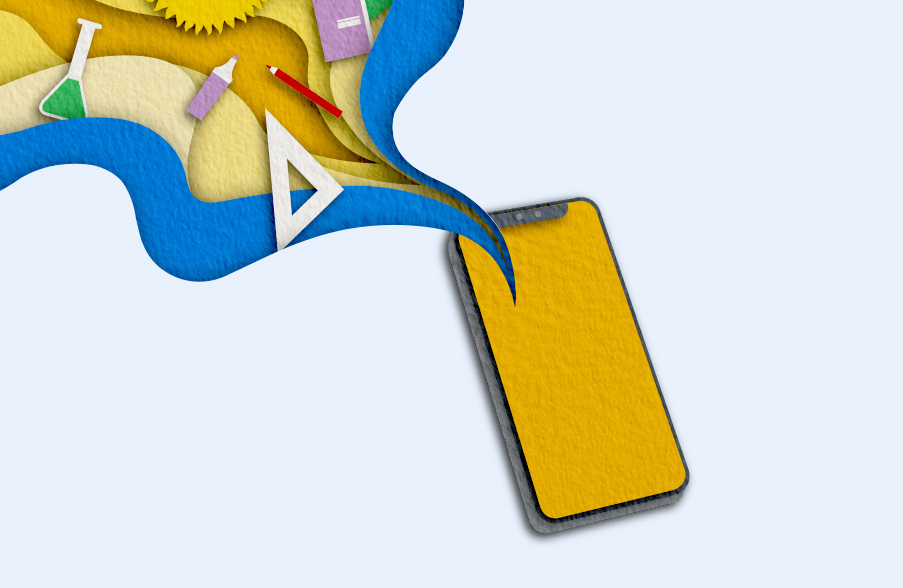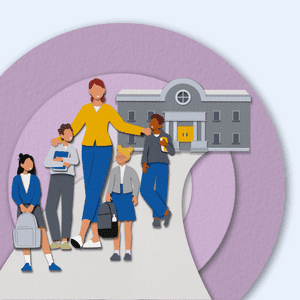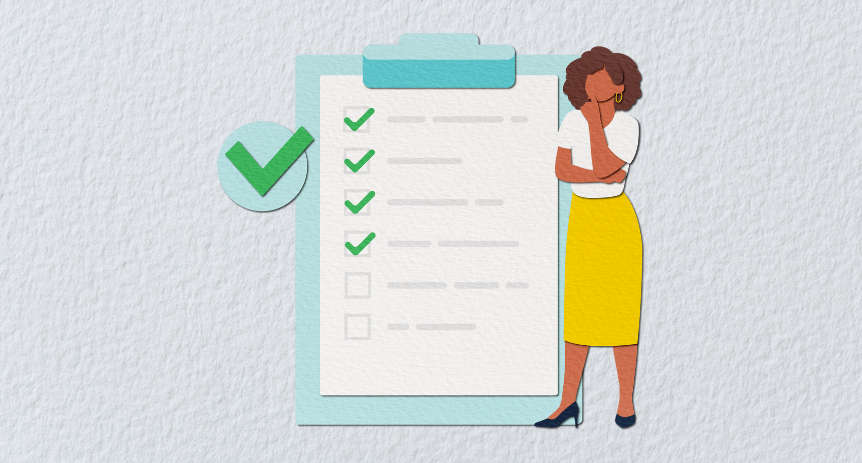No matter how thoroughly you craft your lesson plan, there will come a day when you find yourself with extra time at the end of class. Rather than waste valuable learning time, come equipped with activities to engage your students. Not every activity will be a good fit for every school you substitute at, so be sure to check with the administration if you’re unsure.
Read on for creative projects, movement based activities, as well as writing and thought experiments for all your elementary school needs!
Register to become a sub with Swing today
Elementary school
Here are a few more activity ideas for elementary school classrooms:
1. Play telephone
In this classic game, players whisper a message from person to person. Inevitably, the message changes along the way. When the last person says what they think the message is aloud, it’s often very different from where it began.
Telephone teaches kids about the importance of listening closely. It also might be an interesting jumping off point to talk to older kids about how information changes when it passes through different channels (as it does constantly on the internet).
2. Play ‘20 Questions’
“20 Questions” is a guessing game that helps students learn how to use reason and logic. Choose one student to be the “answerer” who knows the “answer” — a person, place, or thing that the other students will try to guess.
Students will have 20 opportunities to narrow the question down and find the answer. For example, they might start with a question like, “Is it smaller than a bowling ball?” and lead to the final question, “Is it a classroom tool?” to determine that the answer is a stapler.
3. Hold an open question session
Sometimes, students just need an open forum to ask questions during a particularly complex lesson. Before jumping in and answering, open each student’s question to the class and guide and refine their answers as needed.
4. Write a short story inspired by one of their favorite songs
Ask students to think of one of their favorite songs and write a short story. They can write about the storyline, images, or themes of the song. Students can volunteer to read their stories aloud if time permits. This works especially well with older elementary and middle school-aged students.
5. Write a poem about an upcoming event
The smell of roasting turkey? The cackles of witches flying overhead? Warm hot chocolate during a winter celebration? Writing about the holidays or other special events is a great opportunity to engage students in descriptive writing. As a bonus, encourage students to share their poem as a heartfelt gift for their family members.
6. Draw a picture
This one’s really simple. All students need is a piece of paper and a pen. Ask them to draw something from sight — or have them imagine and draw something related to a lesson plan (e.g., a historical figure, a scientific concept).
Middle schoolers relish activities — like drawing — that let them connect with their younger selves a bit and aren’t typically included in their school day.
7. Write a song
The easiest way to write a song as a class is to take a well-known melody from a current pop song and ask students to adapt it. Tie it to the lesson plan to make it funny and keep the learning environment light.
8. Show a relevant video and tie it back to class lessons or general learning strategies
There’s no way around it: Video has become a part of education at all levels. Used effectively, it can be a great asset in the classroom.
Some schools require permission for substitutes to use videos and computers. As long as you know this practice is OK with school administration and are comfortable with the technology, consider showing a relevant video at the end of class and tying it in. You’re engaging different parts of the brain and adding useful knowledge to the lesson.
The most straightforward way to incorporate video into the day is to pick a relevant video and talk to the class about how it relates to the lesson. Here are a few examples of videos you might use:
- The Awareness Test — This fun test of student awareness helps students understand the importance of paying attention. This video is great if you have an especially distracted class!
- Eric Whitacre: A Virtual Choir 2,000 Voices Strong — This user-generated choir is created out of 2,000-plus submitted videos. It can inspire students and show them the limitlessness of creativity.
- The Power of Words — This video, which portrays a fictional interaction between a woman and a homeless man, underscores the power of words.
- TED-Ed project is TED’s education initiative. It has carefully curated videos related to a wide range of topics, from literary terms to physics to philosophy and more.
9. … or just show a fun video that will make them laugh
You can also entertain them with a brief, wholesome video and give them a good laugh. Marcel the Shell with Shoes On is a great example of a video that’s fun for students of just about any age. Silly, adorable, and endlessly quotable, Marcel will capture students’ hearts.
<<What substitute teachers can do when students finish early>>
10. Play ‘Silent Ball’
You’ll need one small ball for this activity. It should be an appropriate size for the age of your students. Clear an area in the center of the room and select a leader to start. They will count down “3, 2, 1, silent” and pass the ball to another person. This person then passes it on. Students must sit down if they drop the ball, miss a pass, or make any noise at all! Whoever remains standing at the end is the winner. In addition to burning kinetic energy, this activity builds hand-eye coordination and non-verbal communication.
11. Vocabulary bingo
Create bingo cards with vocabulary words and play Bingo using definitions or synonyms as clues.
12. Write a thank-you note
Studies continue to explore the benefits of feeling gratitude, which include lower stress levels, increased happiness, and better sleep. What middle-schooler can’t use those things? Have students write down three things in their lives they are grateful for and then choose from the list to compose a thank-you note to a person in their lives who made it possible.
13. Current events discussion
Discuss recent news stories or current events and their implications.
14. Read them a story
Everyone loves a good story, and you may be surprised at how attentive middle-grade students can be to a picture book. Pick an inspiring one such as Dr. Seuss’s classic Oh, The Places You’ll Go!, or an inventive one that most have never read, like Oliver Jeffers’ How to Catch a Star, or Drew Daywalt and Adam Rex’s The Legend of Rock, Paper, Scissors.
15. Would you rather?
Pose ‘would you rather’ questions to the class for a fun and engaging discussion.
16. Debate
Pick a simple topic and divide the class into two groups for a structured debate.
Long-term assignments
17. Write in journals
If you’ve been with students long enough, you’ll know if they keep regular journals. If the lesson ends early, consider asking your students to take them out and write a short passage about the day. It can include any good news or challenges they face. The goal is simple — get them thinking about and practicing how to put those thoughts on paper. Make this a routine to get the most out of it.
18. Put students in the hot seat
For a great review activity, have students take turns sitting in the “hot seat.” Behind them, write a vocabulary word. The student in the hot seat can call on three of their classmates to give them clues about the word without saying it. This will keep the rest of the class engaged, even when they themselves aren’t on the seat! You can use this for a daily review, but it can also work well if you’ve been with students for the duration of one chapter or unit.
19. Play ‘Heads-Up!’
For this game, create sticky-notes with vocabulary words, the names of fictional characters, science concepts, or any other relevant classroom topic. Have the students put the sticky-notes on their heads without looking at them. Their partners try to get the other student to guess what’s written on their card without saying it.
20. Play ‘Pass the Chicken’
As long as you don’t mind traveling with a rubber chicken, you can play this silly review game with your class. The chicken gets passed from student to student. Ask one student a question and tell the student to answer it before the chicken reaches them. If the chicken reaches them before they can answer, they go to the center of the class or “the pot.” If another student can’t answer a question, the student in the middle gets a chance to get out of the pot.
These activities offer a mix of creativity, collaboration, and educational value, making them suitable for various classroom settings and age groups.






